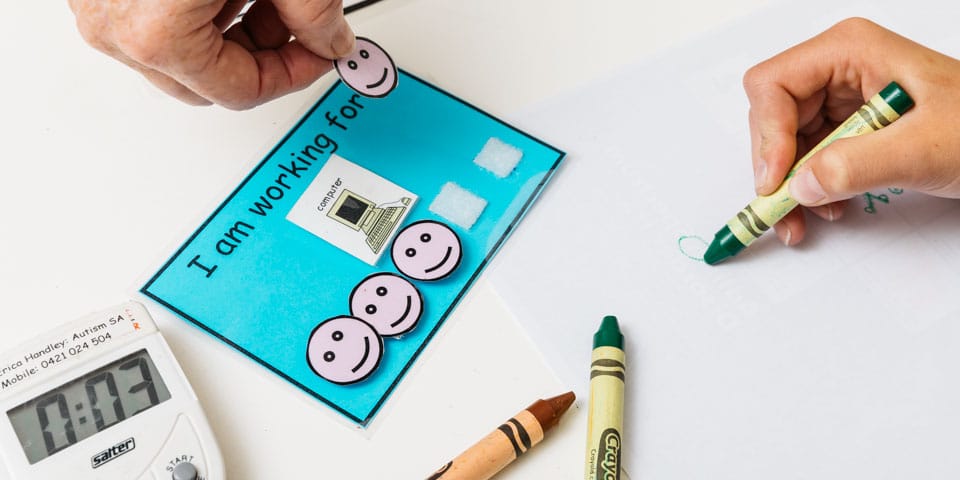Autism behavioural strategies
If only you knew how challenging your behaviour is for me…wearing perfume, not saying what you mean.
Behaviour is everything that we do — it’s how we act in any situation.
There’s always a reason why we behave the way we do. We get a drink because we’re thirsty, we smile because we want to be friendly, we cry because we’re feeling sad.
Often, our behaviours are a response to our environment or those around us. We might see someone that is sad and want to make them feel better, so we give them a hug. Or we might hear a loud noise and look to see what it is.
As we develop, our behaviour is not just a response to another person’s behaviour, but to our understanding of why people behave a certain way. For example, we might realise that someone is acting in an angry way because they are stressed, and ask them if they are okay, rather than getting angry at them.

How does autism impact behaviour?
Autism can influence the way that a person attends, interprets and responds to others and the world around them. This often means that the behaviours that a person with autism displays in situations or interactions, can be unexpected. This is part of the diversity of our world.
If you’re on the spectrum, you might be detail oriented, good at identifying irregularities and a logical thinker, so you might notice specific information or be good at solving problems on topics (or in areas) that others may not see or notice.
You might process sensory information differently, which gives you a unique way of experiencing the world. You might express this through art, music or blogging, to help others gain a broader perspective.
If you need a strict routine to feel safe and secure, you might always be on time and get frustrated when others are not.
Other ways that autism can impact on behaviour can be more challenging. Aggressive behaviour may be the outward expression of your frustration at not being able to express what you want. Self-harming behaviours may also occur if you’re feeling overwhelmed by too much sensory input coming in.
People on the autism spectrum may behave in unexpected ways. Reasons for this can include the following:
- Being unaware of other people’s wants, needs or desires.
- Having trouble communicating your own needs, wants or desires.
- Finding it hard to predict other people’s behaviours and not knowing what behaviours are ‘expected’ in different situations’.
- Having underlying physical, neurological, mental or emotional health issues that impact your wellbeing.
- Having sensory issues that you are responding to, such as light or touch causing pain, or loud noise making it difficult to focus.
- Being hypervigilant, or unable to self-regulate, which means you are more reactive in a situation rather than stopping and thinking before acting.
People with autism may be more delayed in developing what is known as Theory of the Mind, or may not develop it at all.
As psychologist Brittany N Thompson writes in Psychology Today:
“Overall, Theory of Mind involves understanding another person’s knowledge, beliefs, emotions, and intentions and using that understanding to navigate social situations.”
This can lead to some of the behaviours mentioned above, such as not knowing what behaviours are ‘expected’ in social situations, or not understanding that another person’s perception may be different to theirs.
What are behaviours of concern?
Generally speaking, a behaviour becomes a behaviour of concern when it starts to impact our quality of life or negatively affects those around us.
A behaviour becomes a behaviour of concern when it:
- Seriously limits or denies the use of ordinary community facilities, limits or denies lifestyle opportunities.
- Impedes positive interactions with others in their environment.
- Leads to responses that are restrictive, aversive, or result in exclusion.
The Department of Human Services SA defines behaviours of concern as:
“A behaviour that is a barrier to a person participating in, and contributing to, their community (including both active and passive behaviours), that undermines, directly or indirectly, a person’s rights, dignity or quality of life, and poses a risk to the health and safety of a person and those with whom they live or work.”
Behaviours of concern can include the following:
- Verbal aggression – eg. threatening, abusive language.
- Physical aggression against objects – eg. throwing, breaking, swiping.
- Physical aggression against self – eg. head banging, scratching, hair pulling.
- Physical aggression against other people – eg. hitting, slapping, punching.
- Inappropriate sexual behaviour – eg. sexual talk, exposing body parts.
- Perseveration / repetitive behaviour – eg. asking the same question over and over.
- Wandering / absconding – eg. leaving school grounds, entering prohibited areas.
- Inappropriate social behaviour – eg. poor hygiene, commenting on someone’s appearance.
- Lack of initiation – eg. not leaving the house.
Our experiences are all unique. Regardless, I do believe that it is important to find the beautiful. Recognise that there is bad, there is ugly, there is disrespect, there is ignorance and there are meltdowns. Those things are inevitable. But there is also good.
When a behaviour becomes a concern, it is important to identify the reason for the behaviour. Often, a concerning behaviour happens when a person with autism cannot cope or is overwhelmed but is unable to express it.
Another important thing to consider is the environment certain behaviours may occur in, either physical, psychological or social, and if there’s anything that can be adapted in that environment to prevent or reduce it happening.
For example, if a person with autism displays behaviours of concern when they are hungry, could a snack be put in a place that is easy for them to access? Or if they feel overwhelmed in a noisy environment, could they wear ear defenders when they need to go there?
All behaviours have one or more ‘triggers’ that prompt them – such as an interruption to a routine, a particular noise or an object that brings back a painful and overwhelming memory.
Figuring out what these ‘triggers’ are will help people understand what the person is trying to get out of behaving that way, and this will help them to make changes to the environment, or to learn new skills to prevent it happening again.
Once the reason for the behaviour is understood, strategies can be put in place to minimise it or to replace it with a new, more beneficial, behaviour.

How can you reduce behaviours of concern?
The best way to reduce behaviours of concern, is to ensure you understand why the behaviour is occurring in the first place. Sometimes the reason may seem obvious, but more often than not, the reason the person is displaying a behaviour is complex.
Behavioural practitioners or psychologists can help to address behaviours of concern, by identifying their function (the reason they are occurring), modifying the environment, teaching new skills, and reinforcing alternative behaviours.
Intervention approaches are designed to teach new alternative behaviours, as well as ways to put them into practice in different situations. They also motivate people to use these new alternative behaviours to get their needs met.
There are many different techniques and strategies that are used in behavioural interventions and there is no single approach that works for everyone. If one isn’t successful, it doesn’t mean another won’t be. Often, they work best as part of a multi-component approach.
It’s important to remember that it can often take time when trying to address long-standing behaviours of concern, but through a structured, planned approach, behaviours of concern can be reduced, improving the quality of life for the individual and those around them. Make sure you take time to celebrate successes.
What is Positive Behaviour Support?
The main aim of Positive Behaviour Support, or PBS, is to improve a person’s quality of life and reduce behaviours of concern.
PBS is an approach which incorporates different theoretical frameworks and various strategies, focusing on the improvement of quality of life, and the reduction and prevention of the occurrence of behaviours of concern, through teaching new skills and making changes in an individual’s environment. Positive Behaviour Support relies on person-centred strategies that are respectful of an individual’s rights, dignity and overall wellbeing.
It involves an individualised plan that is tailored to the behaviour and needs of the individual and those around them. The plan is implemented by everyone involved in their daily life in the places where that behaviour naturally occurs.
PBS is based on the idea that concerning behaviour can be reduced if we understand what is causing the behaviour to occur, and the function of the behaviour, eg. what is the person getting out of the behaviour?
The learner can then develop new alternative ways of achieving what they want, and can work toward replacing the concerning behaviour.
For example, it might teach them to use a word or sign to express what they want to replace an aggressive action.
If you are considering Positive Behaviour Support, the first step is a functional behavioural assessment.
A functional behavioural assessment is a process to work out why a person is displaying a particular behaviour. Behaviour practitioners such as psychologists, or therapists work with family members and other professionals to observe the behaviour, and gather information to develop a hypothesis as to why they are using that behaviour.
This includes defining the behaviour, understanding what triggers the behaviour to occur, and what benefits the person is getting from that behaviour.
From this, a PBS plan can be put together that includes:
- Removing or reducing the triggers that cause the behaviour.
- Adjusting the environment around the person.
- Teaching and encouraging new skills and other ways to communicate their wants and needs so there is no need for the behaviour of concern.
- Motivating the person to use their new skills in different environments to get their needs met.
- Reducing or removing any benefits they are getting from displaying the behaviour of concern.
Research supports the PBS approach, though its success requires consistent and intensive practice.
Modifying the environment to help with behaviour
Different environments can trigger different behaviours. An environment can be a physical space – a room at home, a supermarket, a park, a relative’s house etc – or it can be what’s in that space – people, noise, lights, animals, toys etc.
Even when an environment doesn’t cause a behaviour, it can still be contributing to its occurrence.
Once you understand why a behaviour of concern is happening, you can look at the environment it occurs in, and make adjustments to that environment.
This may involve:
- Moving items, such as putting food or drink where it’s easy to reach.
- Using a visual schedule so a person knows what is going to happen, for how long, and in what order.
- Modifying a task, or providing adjustments, so that it is achievable.
- Using better and simpler communication to ensure understanding.
- Showing what the expected behaviours are, such as lining up at the supermarket checkout or putting your hand up to ask a question.
- Making sure they can easily access sensory tools such as ear defenders, sunglasses, move’n sit cushions etc.
- Changing the time of day that you go to that environment, such as a quieter time to go shopping, or when the line is not as long.
- Changing an everyday item, such as a hairbrush, toothbrush, or wearing clothes without tags.
- Engaging with a person and providing attention.
Applied Behaviour Analysis (ABA)
When talking about behavioural interventions, you might hear the term Applied Behaviour Analysis, or ABA. This is sometimes called Early Intensive Behavioural Intervention (EIBI) or Intensive Behavioural Intervention (IBI).
All of these terms refer to a range of techniques or strategies that are sometimes used in behavioural interventions. Generally, they involve identifying a behaviour or skill, setting a goal towards it and teaching in it a highly structured way – in tiny steps that can be easily achieved.
This might target a specific behaviour, such as a child banging their head on the wall when they’re upset; or skill, such as washing hands or saying a particular word. It might also look at a broader area of self-development, such as improving communication abilities.
Progress is measured throughout so that changes can be made to suit the person’s needs.
Early intensive behavioural intervention assists pre-school children on the autism spectrum by combining several therapies or elements of therapies to create a targeted approach.
If they can’t learn the way we teach, we teach the way they learn.

Using positive reinforcement to encourage behaviours
Positive reinforcement is when something positive occurs after a desired behaviour occurs, such as receiving praise or getting to do something we like, as a reward for the new alternative behaviour.
Rewards are considered ‘concrete’ – when something makes us feel good – or ‘intrinsic’ – when we make someone else feel good.
Think of it in terms of “If I do x, I will get something I like” (concrete) versus “If I do x, I will make my mum happy” (intrinsic).
Positive reinforcement can help motivate the person showing concerning behaviours to use new skills or desirable behaviours.
Note that some people on the spectrum respond best to concrete reinforcement as they can have difficulty understanding how other people feel. It’s important to understand which you or your loved one responds to for this to be effective.
When using positive reinforcement:
- Make sure the reward is something that will motivate them. It could be verbal praise or a token such as a treat, an activity they enjoy, time spent on their favourite interest etc.
- Combine the token with verbal praise. Use descriptive praise to communicate clearly what they are being praised for. For example, saying, “I really like the way you washed your hands with the soap,” or “You did really well staying with me at the shops”. Reinforce the effort they’ve made.
- In the beginning, use the positive reinforcement every time they demonstrate the new skill/behaviour. Once the skill is learnt, gradually fade the reward out.
- Don’t be tempted to offer the reward before the behaviour. Then it is no longer reinforcing the behaviour, it is creating it through bribery, which is less effective in the long-term.
- Never take a reward away or use it as a punishment.
- If positive reinforcement is not working, review it to look at why and adjust. Perhaps the reinforcement on offer is not motivating enough.
Behaviour difficulties and strategies across the ages
I might hit developmental and societal milestones in a different order than my peers, but I am able to accomplish these small victories on my own time.
It’s worth remembering that everyone has challenging behaviours as children, whether they are on the autism spectrum or not. Everyone has to learn to overcome their challenging behaviours and find more beneficial ones.
For people on the autism spectrum, however, this process can be slower and take a lot more effort.
Depending on how autism impacts you or your loved one, behaviours of concern may occur at certain times of life or across their entire life. Everyone on the spectrum will have their own unique challenges and unique ways of dealing with those challenges.
For information about where to find support and or professional services to better understand autism, or your child on the spectrum go to our supports and services page.
Commonly used behavioural strategies
Antecedent-based interventions
Antecedent-based interventions (ABIs) are modifications made to an environment or context with the aim of changing or shaping a person with autism’s behaviour.
They are typically implemented following a behaviour assessment, factoring in the environment that may be impacting.
Once these factors are identified, ABIs are implemented to modify the environment or context so that it has less of an impact on behaviour.
ABIs may include:
- Changing educational activities or materials.
- Incorporating choice in educational activities or materials.
- Priming ahead of time for upcoming activities.
- Varying the format, difficulty level, or order of instruction during activities.
- Enriching environments to provide additional visual cues, or access to sensory stimuli.
- Modifying and reinforcing schedules.
These strategies are often used in conjunction with other evidence-based practices, including functional communication training and reinforcement.
Cognitive behavioural intervention
Cognitive behavioural intervention (CBI) is based on the idea that behaviour can be modified or improved through cognitive (mental) processes.
People with autism are taught to examine their emotions to recognise when negative thoughts are escalating in intensity, and are then given strategies to change their thinking, and ultimately their behaviour.
These interventions tend to be used with autistic people who display problematic behaviour, such as anger or anxiety.
CBIs are often used in conjunction with other evidence-based interventions.
Discrete trial teaching
Discrete trial teaching (DTT) is an instructional approach used to teach skills in a one on one, controlled, and structured environment.
It involves repeating instructional trials that have a definite beginning and end: beginning with the parent or teacher presenting a clear direction or stimuli to elicits a specific behaviour. Desired skills or behaviours are reinforced through positive praise and tangible rewards.
Other behavioural practices that are used in DTT include task analysis, reinforcement, prompting behaviour, and time delay practices.
Extinction strategies
Extinction (EXT) is used to reduce or eliminate a challenging behaviour, and relies on accurately identifying the problematic behaviour, and the consequences that reinforce that behaviour.
The consequence that is believed to reinforce the behaviour is removed or withdrawn, resulting in the reduction (or extinction) of the behaviour.
Keep in mind, that an initial increase in the challenging behaviour (referred to as an “extinction burst”) is common, but it should eventually be reduced or may stop completely.
Extinction practices should not be used in isolation, but in combination with differential reinforcement and functional behaviour assessment.
مدلسازی
Modelling (MD) involves the demonstration of a desired target behaviour, resulting in imitation of the behaviour, which should ultimately lead to the person with autism achieving the imitated behaviour. MD is often combined with other behavioural strategies, including: prompting, and reinforcement.
Incidental teaching
Often used with other interventions, this approach sees the parent or ‘teacher’ focusing on the things and behaviours that the person with autism is interested in, rather than following a strict learning plan.
If the aim is to get the person with autism to use words, the parent or teacher might put an object they regularly use out of reach, so when they want the object it will encourage them to use words to ask for it.
Pivotal response treatment
Pivotal response treatment is based on the concept that there are ‘pivotal’ parts of a child’s development which are linked to certain behaviours, these being:
- Motivation
- Self-management
- Self-initiation
- The ability to respond to multiple cues.
The treatment focuses on changing behaviour in these pivotal areas.
Response interruption and redirection
Response interruption and redirection (RIR) is the introduction of an action, word, or comment as a ‘prompt’ when interfering behaviour is occurring, to divert the person with autism’s attention away from the interfering behaviour and ultimately reduce its severity.
RIR is used specifically to address behaviours that are repetitive, stereotypical, or cause self-harm or injury. It is implemented following a functional behaviour assessment (FBA) which will help to identify and understand the interfering behaviour.
RIR is particularly effective with behaviours resulting from sensory problems, as it interrupts people from engaging with the interfering behaviour, and prompts them to redirect the behaviour to something more appropriate.
I wish I could read minds, then I would know what they wished for and I could do the right thing. Socialising is harder than any maths equation for me. What works for one person doesn’t for another. People do not always say what they mean, or stick to what they say.
Self-management
Self-management (SM) involves teaching people with autism to distinguish between appropriate and inappropriate behaviours, by accurately monitoring and recording their own behaviours, and reinforcing appropriate behaviours.
Although this approach may initially require parent or teacher support to accurately record behaviours and provide self-reinforcement, this should be reduced overtime in favour of a self-managed approach.
SM is often used in conjunction with other evidence-based practices including video modelling, and visual supports.
Task analysis
Task analysis (TA) involves breaking a complex skill into smaller components, like links in a chain, in order to teach an overall behavioural skill.
The person with autism can be taught to perform individual steps (or links) of the chain until the whole skill is mastered (this can also be called “chaining”).
Other practices including video modelling, or time delay, and reinforcement should be used to assist in teaching the smaller steps in the chain.
As the smaller steps are mastered, people become more independent in their ability to perform the whole skill.
Time delay
Time delay (TD) is used to phase out the use of prompts during instructional activities. This is applied through a brief delay, which is provided between the initial instruction and any additional instructions or prompts.
Time delay is always used in conjunction with a prompting procedure, such as least-to-most prompting, graduated guidance or simultaneous prompting.
Pivotal response training
Pivotal response training (PRT) is a naturalistic intervention that builds on the initiative and interests of the autistic person, and is particularly effective for developing social behaviours, such as communication, language, and play.
It was developed to create a more efficient and effective way of learning through the enhancement of pivotal learning variables, including: motivation, response to cues, self-management, and self-initiations of social interactions.
These skills are seen as ‘pivotal’ because they are the foundational skills upon which people with autism can make major improvements in many other areas of their lives.

Prompting procedures
Prompting procedures (PP) encapsulate any help given to people with autism to assist them in using a specific skill. These may be verbal, gestural, or physical prompts given to people on the spectrum to help them engage in a specific behaviour or skill.
Prompting procedures are considered essential for use in many other evidence-based practices.



